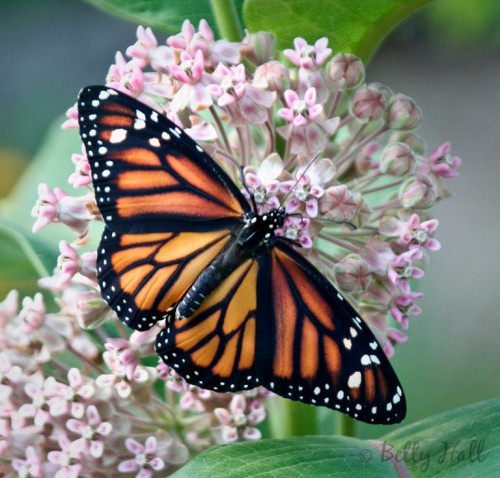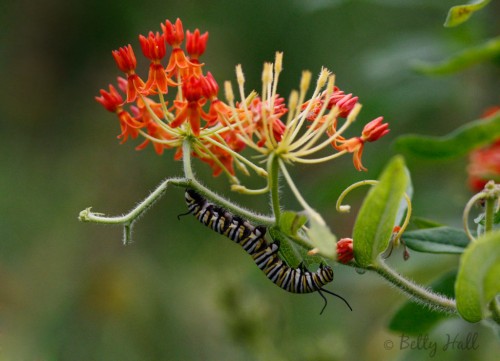By Susan Jonas, member of the Garden Club of Danville, Kentucky and friend of Lexington, KY Chapter of Wild Ones.
A version of this article first appeared in the Danville Advocate-Messenger newspaper in August, 2013

The Garden Club of Kentucky and the Lexington Chapter of Wild Ones want you to plant weeds in your garden. That’s right. These folks are on a mission to add milkweed plants to gardens all over the area. Without them the beautiful gold and black monarch butterflies are in serious trouble these days.
Gardeners, and others who keep a close eye on the natural world, have noticed a sharp decline in the number of butterflies in recent years, particularly monarchs. Like the scarcity of honeybees and amphibians, this is one more sign that all is not right with our world.
Last year (2012), monarch numbers declined 59% compared to the previous year. These figures have caused the World Wildlife Fund to declare the eastern monarch migration to be endangered. What can we do?
Monarch Watch, a national organization sponsored by the University of Kansas, has designed a plan to create “Monarch Waystations” all across America at schools, businesses, homes and municipalities to sustain the butterflies during their life cycle and migration. The Garden Club of Danville and the Lexington Chapter of Wild Ones are both committed and are quickly picking up converts. Once you understand how important and how easy it is, these folks hope you’ll join them.
Two Kentucky gardeners are especially committed. Joanna Kirby of Lancaster, KY is president of the Garden Club of Kentucky. One of her goals is to establish Monarch Waystations all across the state with the help of local garden clubs. Linda Porter of Danville is known as “The Butterfly Lady” and gives presentations to schools and other organizations throughout the state. Both Joanna and Linda are members of the Garden Club of Danville and the Lexington Chapter of Wild Ones and both have certified their own gardens as Monarch Waystations.

You’ve probably seen adult monarchs sipping nectar from many varieties of flowers. But you may not know that milkweeds are the only plants that monarch caterpillars can eat. Without milkweeds the monarchs cannot survive. The adults lay their eggs on milkweed plants and the little caterpillars begin munching as soon as they hatch.
And that is the problem. While milkweeds used to be common in fields and fence rows, they are fast losing habitat to development and the spraying of herbicides. With a name like milkweed it is no surprise that generations of farmers and gardeners have considered the plant just that – a weed. Now we know better.
Monarchs are one of nature’s truly remarkable stories. Populations of the tiny but tough creatures migrate each year from Mexico to Canada and back. It takes four generations of monarchs to make their way from overwintering in Mexico all the way to Canada during the summer and back to Mexico for the winter.
The monarchs you may see in Kentucky gardens in the summer and fall will only live two to six weeks before they lay eggs and die. Providing there are enough milkweeds, those eggs will hatch into butterflies that complete another segment of the migration. It is becoming harder and harder for the butterflies to find enough milkweeds as they cross the country.
If you have a flower garden, you probably already have many of the plants that provide nectar for adult monarchs. With the addition of at least ten milkweed plants and some management practices you could certify your garden as an official Monarch Waystation. Of course, the butterflies don’t care if your garden is certified or not, but registering it lets Monarch Watch keep track of locations and numbers of Waystations across the country.
First, you need at least 100 square feet of space in full sun. The total may be split into several locations, which makes it easy to convert an existing flower garden or landscape.
Second, plant 10 or more milkweed plants, preferably of two or more species. They are not always easy to find, but if enough people ask for them local sources will begin carrying milkweeds. In the Bluegrass area of Kentucky, they are readily available at Springhouse Gardens outside Nicholasville, Michler’s Greenhouse in Lexington, or Shooting Star Nursery in Georgetown (which also ships plants). (Caution – milkweed sap can severely irritate your eyes. If you cut the stems, wear gloves or wash your hands and keep your hands away from your face.)
Third, plant at least four nectar plants so something is blooming throughout the growing season. They may be native trees, shrubs and wildflowers, or the common annuals already in many gardens, such as petunias, lantana, salvia, and zinnias.
The fourth step concerns the way you garden. Plants should be relatively close together but not crowded, to provide shelter. Eliminate the use of herbicides and insecticides. (There are organic substitutes.) Leave some dead plants over the winter to provide shelter for eggs or chrysalises. Cleaning up in the fall may destroy next year’s butterflies. If you prefer to tidy your garden, at least loosely pile the dead plants in an out of the way spot until spring.
Last, find complete information and register your garden as a Certified Monarch Waystation at www.monarchwatch.org. You can fill out the application online or by mail. There is a $16 processing fee. An attractive metal sign can be added for an additional $24.95, so others will know you have a special garden and can learn from you.
In April, 2013 there were 35 Monarch Waystations registered in Kentucky. By fall, there were 95 registered Waystations, thanks to the efforts of the Garden Club of Kentucky and the Lexington Chapter of Wild Ones. Let’s keep adding Monarch Waystations!
Waystations in central Kentucky that are open to the public include:
- Nannine Clay Wallis Arboretum, 616 Pleasant Street in Paris, KY, home of the Garden Club of Kentucky
- Shaker Village of Pleasant Hill, Harrodsburg, Kentucky
- The Boyle County Public Library in Danville
- Springhouse Gardens in Jessamine County
- The Arboretum, Lexington, Kentucky
